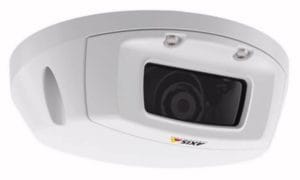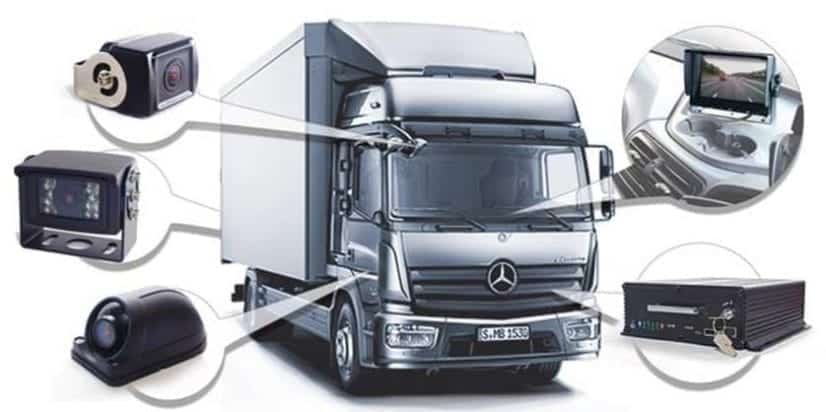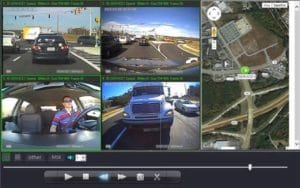On-board cameras are, in the simplest explanation, a camera(s) installed in/on a moving object. Since the early 1980s, on-board cameras were first used in auto racing and in the film industry. They were then adopted by police forces to be used as dash mounted cameras, made famous to the world by the Rodney King trial. Since then, the advancements in video surveillance technology has opened up new doors for on-board cameras. Being able to record or view HD video with cameras small enough to fit on the back of a cell phone, coupled with storage cards reduced to the size of a coin has allowed for many uses of on-board cameras.
 Like other video surveillance products (security video), on-board cameras can be used for more than simply viewing. We are becoming accustomed to using car surveillance cameras for back up cameras. In my most recent vehicle there is also one on the passenger mirror for use in merging and reducing the blind spot. However, with use of video surveillance analytics, an option on new vehicles is using additional cameras allowing the car to see lane dividers. The car’s software will use analytics to communicate with the steering and breaking system to make sure the car:
Like other video surveillance products (security video), on-board cameras can be used for more than simply viewing. We are becoming accustomed to using car surveillance cameras for back up cameras. In my most recent vehicle there is also one on the passenger mirror for use in merging and reducing the blind spot. However, with use of video surveillance analytics, an option on new vehicles is using additional cameras allowing the car to see lane dividers. The car’s software will use analytics to communicate with the steering and breaking system to make sure the car:
- Stays in lane
- Stops early enough
- Auto-parks
Who is using cameras in company vehicles and why?
In the commercial use of on-board cameras we are more focused on dash cams than we are operation of the vehicle. A dashboard placed, on-board camera can be a huge asset for a business owner, school system, government entity, etc.
Taylored Systems is seeing on-board cameras being adopted by school systems and governments faster than the general business sector. Buses are the number one location on-board cameras are being installed (both school and mass transit). They are being used to monitor students/passengers and employees. Many times an incident on a bus is a student’s/passenger’s word against the driver’s. The on-board cameras provide a first-hand “witness” always “sitting” and watching what is happening. On-board cameras are also being used to hold drivers accountable for doing a sweep of the bus before exiting for the night. Lastly, with the correct positioning of the camera, we now have a view of vehicles illegally passing a bus with an extended stop arm.
Government entities are using on-board cameras in a couple of different ways. One way is public safety. On-board car cameras can be extremely helpful in undercover surveillance. The cameras can be controlled remotely and have a small pull from the battery. This allows a properly placed vehicle to serve a purpose in a stake out. Also, cameras can be installed on tactical vehicles for extra eyes when approaching a situation.
Outside of the public safety benefits, governments have adopted in-vehicle cameras for their fleet of vehicles. Just like video surveillance inside of a building, on-board surveillance is used to help protect employees and the company’s assets. http://www.taylored.com/blog/business-surveillance-systems-to-help-keep-employees-safe/
As a business owner, you may wonder why would I need to install on-board cameras? I’m not transporting passengers or fighting crime. However, there are many reasons a company should consider on-board cameras. I discussed this topic with Joey Riggs, USA Sales and Engineering Director for NSV International Corp. NSV manufactures on-board cameras specifically for major auto makers. The auto makers are installing on-board cameras, in the factory, for countries such as Russia and Malaysia. Here is what he said about why they are starting to grow their United States market and why businesses are adopting cameras as part of their fleet requirements.
- Insurance reasons and asset protection
- While it has not been adopted in the United States yet, there is an understanding insurers are on the verge of offering rebates or discounts based on on-board cameras being installed. Some providers in the UK offer a 10-15% discount on premiums for those with on-board cameras installed. In Russia, you cannot obtain vehicle insurance without an on-board camera.
- Having a record of an accident. Many times an insurance claim is caught in limbo because the investigators are held up figuring out the truth. Video evidence will help expedite the process.
- Helping to deter and combat insurance fraud. This will, over time, help reduce insurance premiums for all.
- The asset is now being watched when it is unoccupied. Most on-board cameras will start to record when motion is detected. Because the technology is available for remote viewing, alerts can be set to provide an inside look of an asset.
- Monitoring employees
- Some companies are using the footage to reward safe drivers
- On the other hand, for every 10 good employees it’s inevitable to find one less than good. On-board cameras can provide a company an inside look when a call comes in about a vehicle or if unacceptable driving habits are suspected.
- Behavior can be adjusted when we know we are being monitored. When an employee knows the company is monitoring their driving, the company is promoting safe habits.
How do I obtain the vehicle cameras system captured video?
The main question we get about on-board cameras is how do I get the video from the vehicle? Do I have to rely on the same employee being monitored to provide me with their footage? The answer is, fortunately, no. For those being rewarded, there would be no issue. However, those getting reprimanded for their driving might not be as willing and may consistently “lose” the storage. This can be remedied in a few ways.
- Remotely pull from the storage via Wi-Fi
- Auto download to a server via Wi-Fi
- Storing the data to an SD card which can be removed, but will send an alert if it has been pulled
- Using a port on the device to pull the data stored
What do I need to know before I invest in a solution?
Many times with both on-board video surveillance and traditional video surveillance we get the question of what the end user needs to know. Here are some things to consider…
- What do I want to see?
- How do I want to use the video obtained?
- Who has access to the video?
- How long do I need to keep the video?
- Will I need to submit the video in court?
Often when we meet clients for a site survey, they tell us where they want cameras placed. Telling your video expert what you want to see is more beneficial than where you want it placed. Let your experts determine the type of camera and placement.
If you believe your business could benefit from learning more about on-board cameras or video surveillance, in general, feel free to reach out to the experts at Taylored Systems. We will be happy to sit down and figure out a solution!


